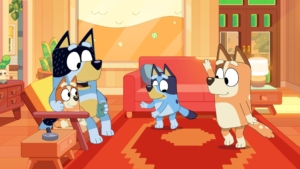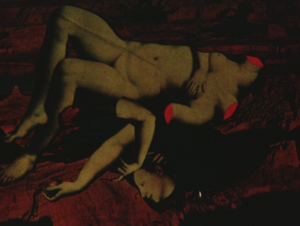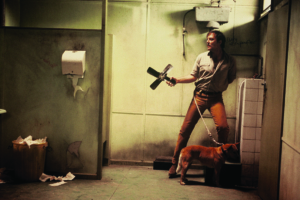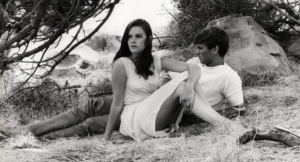Karrabing is not a clan, not a language group, not a nation. It is an aspiration.[1]Elizabeth A Povinelli in conversation with Martina Angelotti, Visible website, 2015, <http://www.visibleproject.org/blog/elizabeth-povinelli-in-conversation-with-martina-angelotti-on-the-karrabing-film-collective-winner-of-the-2015-visible-award/>, accessed 7 November 2018.
There is just one fixed protagonist in the installations and short films of the Karrabing Film Collective: the Australian landscape features prominently in each of its works. However, the reality of life in the Northern Territory’s Indigenous Belyuen community makes such continuity difficult for the human cast and crew. Such factors as economic and health status, legal interventions and premature death rates make this grassroots collective a somewhat-unstable group. In fact, it isn’t unusual for a character to be played by one performer, only to be inexplicably taken over by another later in the film. The reason? Incarceration.
‘[P]art and parcel of the politics and aesthetics of Karrabing films are the constant disturbances that compose their everyday life,’ explains Elizabeth A Povinelli, anthropology academic and a founding member of the collective.
[I]ndigenous people represent 3% of the national population but 28% of the prison population. In these contexts, politics and aesthetics cannot be unwound […] What might appear to be aesthetic slippages are actually the aesthetic registers of Indigenous life in settler liberalism […] We could insert extradiegetic footage but we think that allowing unavoidable inconsistencies to be a part of the visual field might be more powerful.[2]ibid.
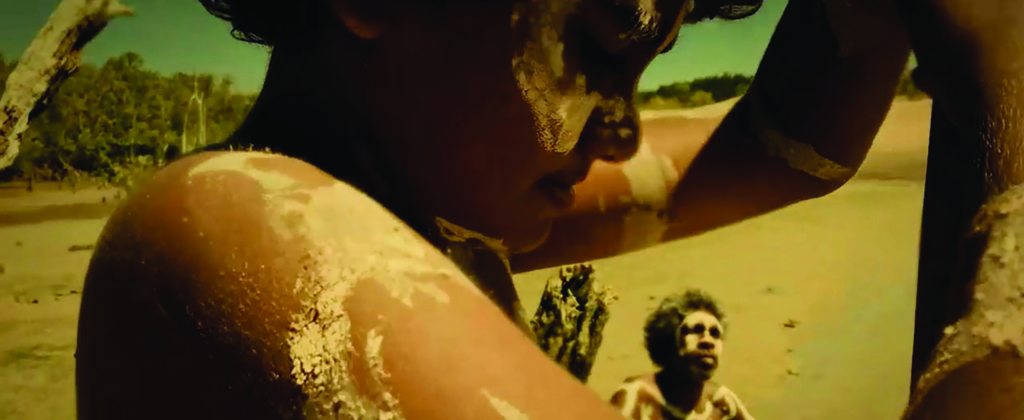
These ‘unavoidable inconsistencies’ make for an aesthetic regime that is highly fluid and inherently political. So, too, does the recurring Top End location, which is home to most of the collective’s forty-six members.[3]The collective’s members as at June 2018 are listed in the page for The Mermaids: Mirror Worlds on the Institute of Modern Art website, <https://ima.org.au/karrabing-film-collective/>, accessed 7 November 2018. In keeping with the grassroots philosophy of the collective as well as the ‘faux realism’ so central to its style, its films’ choice of location sets off a complex relay of imagery. In this way, the setting signifies (usually simultaneously) a backdrop for inter-clan rivalries and jealousies, a reimagined and forcefully reclaimed Indigenous space, and a contested site of ownership that magnifies the post-Mabo political climate. But, most importantly, every frame composed by Karrabing is filtered through an uncompromisingly Aboriginal lens. Its experimental, improvisational filmmaking refuses to offer up depictions of the land or Indigenous Australians that cater to a Western gaze. Instead, their diegetic contexts are marvellously self-regulated, resisting dominant film language and narrative conventions in favour of moving towards new modes of self-representation. Karrabing films are a kind of working-out, of sensing what is possible, of refusing the language of the oppressor in favour of the ‘multileveled worlds’[4]Tess Lea & Elizabeth A Povinelli, ‘Karrabing: An Essay in Keywords’, Visual Anthropology Review, vol. 34, no. 1, Spring 2018, p. 36. lived by Indigenous individuals.}}
The Karrabing Film Collective politicises Indigenous agency through its means of production, development, aesthetics and (often provocative) intercession in the representation of Indigenous Australians. Drawing on the practices of ‘Third Cinema’ – which takes as its starting point the ‘anti-imperialist struggle of the peoples of the Third World and of their equivalents inside the imperialist countries’, ultimately aiming for ‘the decolonization of culture’[5]Octavio Getino & Fernando Solanas, ‘Toward a Third Cinema’, Tricontinental, no. 14, October 1969, p. 116, emphasis removed. – Karrabing engages with contemporary Australian sociopolitical dialogue about place, persecution, government policy and history. The collective was founded in 2008 in response to the previous year’s Northern Territory ‘Emergency Response’ (NTER), a A$587 million intervention in the form of controversial legislation amendments that significantly undermined the human rights of Aboriginal communities. Issues of land and ownership were foregrounded when sixty-five Aboriginal communities were acquired by mandate of the Commonwealth.[6]‘What Is the Northern Territory Intervention?’, Monash University website, <https://www.monash.edu/law/research/centres/castancentre/our-research-areas/indigenous-research/the-northern-territory-intervention/the-northern-territory-intervention-an-evaluation/what-is-the-northern-territory-intervention>, accessed 7 November 2018. A United Nations official denounced the policies, stating, ‘These measures overtly discriminate against Aboriginal peoples, infringe their right of self-determination and stigmatise already-stigmatised communities.’[7]James Anaya, quoted in ‘UN Condemns Aboriginal Treatment’, BBC News, 27 August 2009, <http://news.bbc.co.uk/2/hi/asia-pacific/8223881.stm>, accessed 7 November 2018.
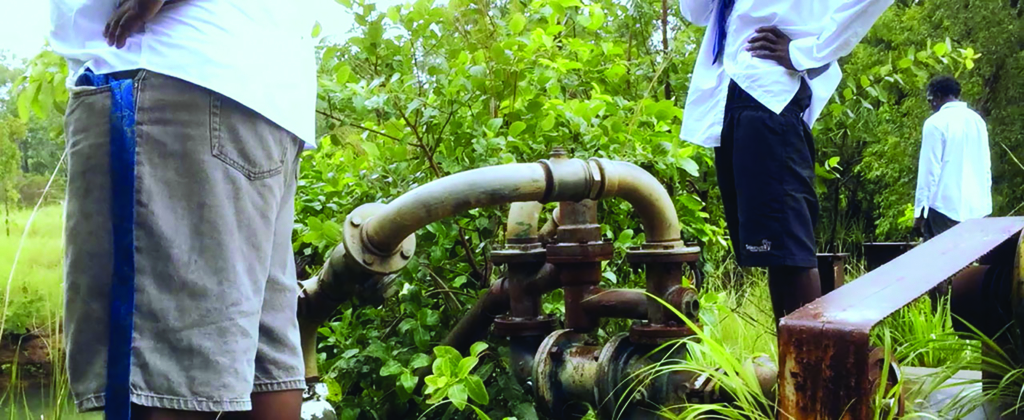
Given this history, it is no wonder that the importance of place is always front and centre in Karrabing works; after all, sacred Aboriginal lands are sites of connection between clans and families. The coastline of Anson Bay, south-west of Darwin, is particularly significant – many members identify that region as their country[8]Lea & Povinelli, op. cit., p. 37. – so it’s fitting that the collective takes up water as a central motif. Clearly, form and meaning are mutually reliant in a Karrabing film, with context always impinging on style, narrative, tropes and even continuity.
In the Emmiyengal language, ‘karrabing’ means ‘tide out’ … Much like the coastline, the collective occupies a transitional space, taking up the voices of past, present and even future ancestors, and reimagining these within a range of politically charged contexts.
In the Emmiyengal language, ‘karrabing’ means ‘tide out’,[9]The Mermaids: Mirror Worlds, op. cit. and the metaphor of an ocean’s tide is a potent one. There is the elemental symbolism of water as a source of cathartic purification; a sense of renewal is signalled by the inward surge of water that cleanses the landscape. Beyond this, there is also the possibility of discovery, of history both rewritten and rediscovered. Just as the tide reshapes the shoreline as it passes back and forth, so does it draw out buried flotsam, fossils and other ocean debris. Much like the coastline, the collective occupies a transitional space, taking up the voices of past, present and even future ancestors, and reimagining these within a range of politically charged contexts. The act of ‘fossilling’ is particularly resonant for the organisation: the idea of excavating and reappropriating dominant settler narratives is at the heart of its philosophy.
Night Time Go (2017), The Jealous One (2017) and The Mermaids, or Aiden in Wonderland (2018), all directed by Povinelli, are three new works that continue Karrabing’s interrogation of the precarious state of Indigenous life in Australia. The films played at sold-out sessions at the 2018 Melbourne International Film Festival and have been exhibited internationally, including at London’s Tate Modern and New York’s UnionDocs Center for Documentary Art.
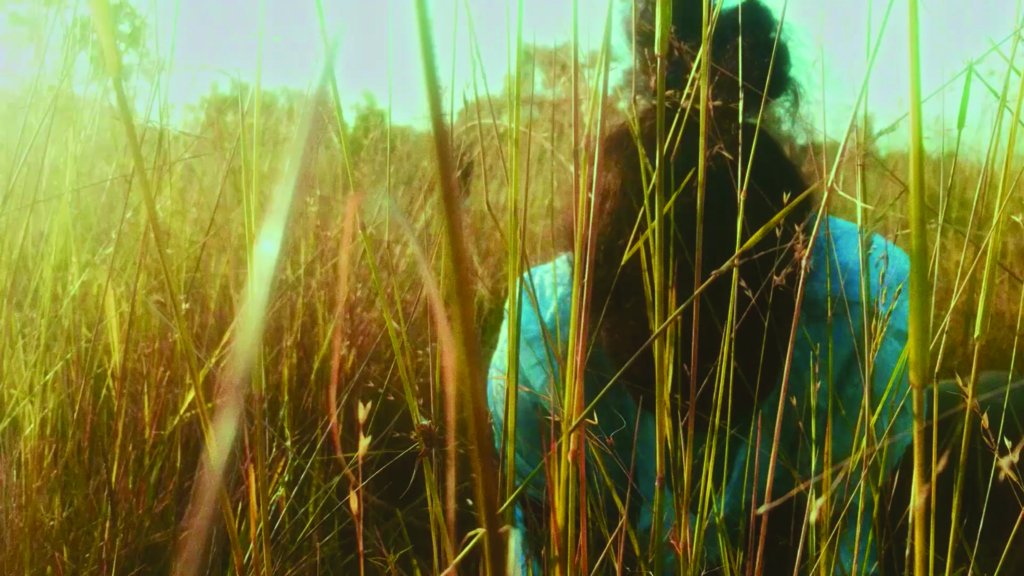
Night Time Go presents a revised history that is rooted in real events: on 19 September 1943, a party of Karrabing ancestors fled a World War II internment camp and travelled over 300 kilometres on foot to return to their homelands. Karrabing member Sheree Bianamu recalls her mother telling her the story of this escape; she, in turn, was told by her own parents.[10]Sheree Bianamu, in ‘Karrabing Film Collective – Conversation’, YouTube, 3 November 2017, <https://www.youtube.com/watch?v=e7z6qu3RIR8>, accessed 7 November 2018. This fusing of history with mythology is a keynote of Karrabing’s filmmaking and, here, the typically atemporal register is used formally, with manipulated archival footage intercut with slyly anachronistic sequences. Night Time Go salvages this history and frees it from the dominant colonial narrative; it imagines an alternative context in which the Aboriginal escapees incite an uprising, forcing the colonists away from their land.
Povinelli has pointed out that the archival footage was hard to come by: ‘There’s no record of these internment camps […] Why bother keeping a record of something that you just were trying to make disappear?’[11]Elizabeth A Povinelli, in ‘Karrabing Film Collective – Conversation’, ibid. Perhaps because of – or in response to – this, Night Time Go is characterised by a free-flowing, borderless rhythm that also captures Indigenous Australians’ nonlinear understanding of reality. As an oft-quoted Aboriginal adage goes, ‘We don’t have boundaries like fences, as farmers do. We have spiritual connections.’[12]Cited in ‘Dreamtime Meaning’, Aboriginal Art & Culture website, <http://www.aboriginalart.com.au/culture/dreamtime2.html>, accessed 7 November 2018.
The collective uses film as a vehicle for social analysis, but also as a tool for learning and reconnecting with Dreamtime lore – and keeping it alive … The spirits of ancestors endure through the spirits of modern-day Aboriginal Australians.
The idea that the spiritual world consists of a multiplicity of living forms that reside in the skin of the Earth, bodies of water and in the bodies of living Aboriginal people is strikingly conveyed in these films. There are jarringly discordant jump cuts, time and space are depicted as unstable, and there is an almost-constant state of disjuncture as memories, stories, families and inter-clan relationships collide. There is an overlaying of ancestral spirits onto contemporary settings and narratives, really conveying that sense of a ‘multileveled world’. There is an avant-garde energy to the films insofar as they resist categorisation, refusing to be pinned down to any Western ideas about what a screen work should look, feel or sound like.
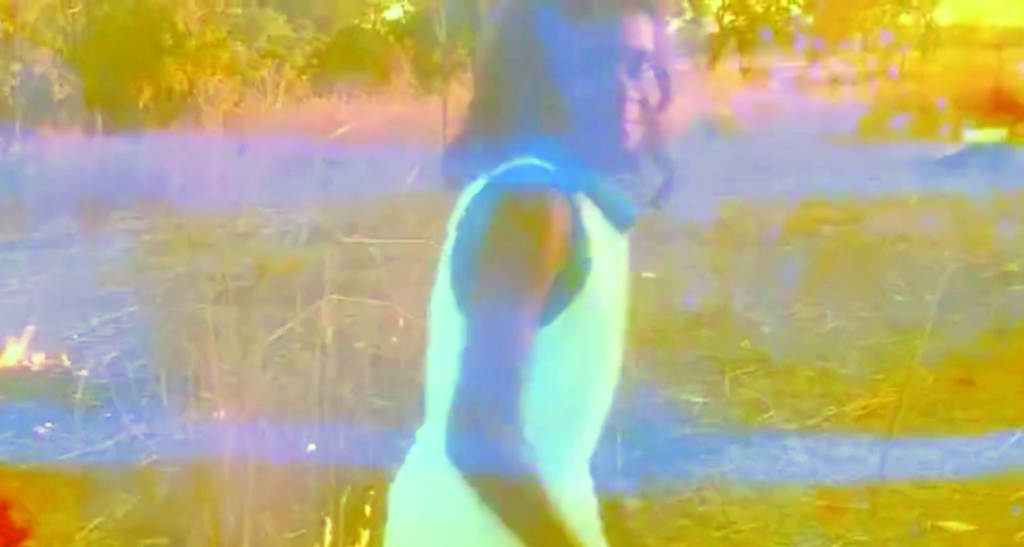
Povinelli and anthropologist Tess Lea cite ‘fabulation’ as a strategy employed by Karrabing,[13]Lea & Povinelli, op. cit., p. 36. but this is perhaps better understood as an attempt to embed the Dreaming into the fabric of its work. The collective uses film as a vehicle for social analysis, but also as a tool for learning and reconnecting with Dreamtime lore – and keeping it alive. As Karrabing member Natasha Lewis Bigfoot puts it:
[W]e play it in the now times so it is not just in the past; it is here inside us, like when we always say [it’s] in our sweat. We work to make the film and the film also helps us make it really real to ourselves. It is now because it is still there.[14]Natasha Lewis Bigfoot, quoted in The Karrabing Film Collective, ‘Growing Up Karrabing: A Conversation with Gavin Bianamu, Sheree Bianamu, Natasha Lewis Bigfoot, Ethan Jorrock and Elizabeth Povinelli’, un Magazine, issue 11.2, October 2017, <http://unprojects.org.au/magazine/issues/issue-11-2/growing-up-karrabing/>, accessed 7 November 2018.
The spirits of ancestors endure through the spirits of modern-day Aboriginal Australians. Rather than the West’s wistful sensibility of deceased loved ones ‘living on’ in our memories, Aboriginal communities believe that their ancestors are very much alive and present.
The Jealous One tells the story of a jealous spirit who is incensed when his wife spends too much time in the company of others. The concept is based on a Karrabing member’s spirit (a sea creature that makes him forever jealous) – again, the living, breathing Dreaming is what directs the story of the created text. This is interposed with a concurrent narrative about an Aboriginal man trying to get to a funeral; he is unable to gain access to his own sacred land. The white bureaucratic machine is aptly depicted as a woman whose face remains out of frame: impersonal, irrelevant, yet still calling the shots. Indeed, in the Belyuen community today, access to goods and services is still controlled by white people. Even in a so-called Indigenous community, living on sacred land, the continuing struggle for autonomy and propriety is part of the tapestry of daily life for Karrabing’s members and their Indigenous peers.
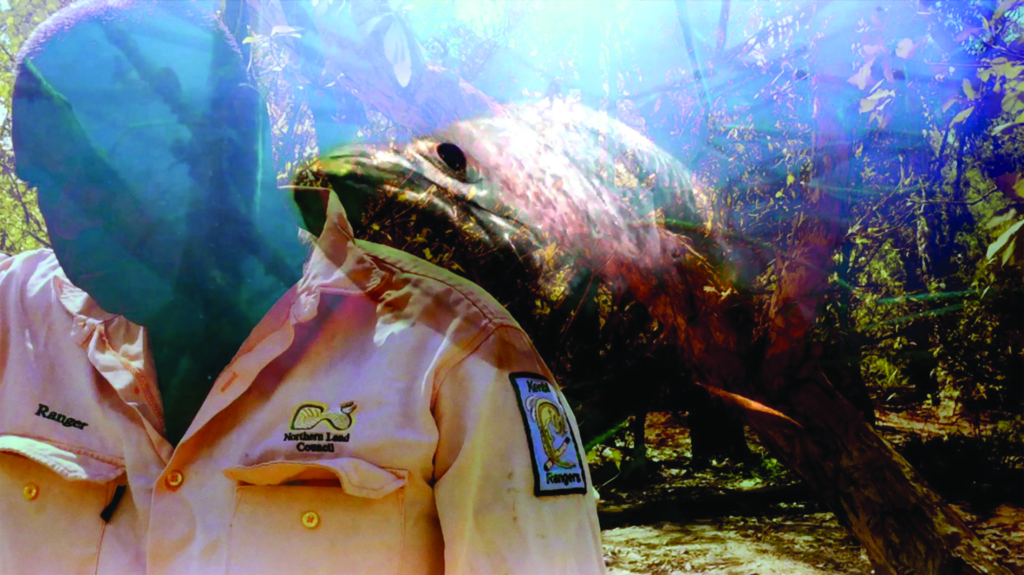
The Mermaids, or Aiden in Wonderland subsumes some science fiction elements into a distinctly Aboriginal storytelling framework. In a future where only Indigenous Australians are able to survive the polluted atmosphere outdoors, scientists are experimenting on them to find a cure. Aiden goes back to his ancestral lands to seek protection from mermaids, only to discover that they, too, are being taken for experiments. There is a real handmade feel to this film that magnifies the authenticity of the voices featured: Karrabing members now shoot on iPhones so that they no longer need to rely on white crew to facilitate (or intervene in) the actualisation of their creative visions. They also work to their own schedules and to the authentic rhythms of the collective. As each member interchangeably assumes the roles of cast and crew, the multiplicity of experience and the lack of ‘straight-line’ thinking have become central aspects of their production model. And the Western spectator is cast adrift by the resulting films, as the power dialectic is fundamentally reconfigured in the service of an Aboriginal mode of address.
Beyond the sociopolitical reach of these films as living artefacts, it is the community-driven nature of the group that is perhaps most transformative. Bianamu puts it like this:
When we started doing these movies it sorta changed our ways. When we sorta move on with our lives and this is what made us choose. We’re not gonna stop doing what we’re doing now […] Make us stronger and make us feel much happier and try to be a role model to our community.[15]Sheree Bianamu, in ‘Karrabing Film Collective – Conversation’, op. cit.
Endnotes
| 1 | Elizabeth A Povinelli in conversation with Martina Angelotti, Visible website, 2015, <http://www.visibleproject.org/blog/elizabeth-povinelli-in-conversation-with-martina-angelotti-on-the-karrabing-film-collective-winner-of-the-2015-visible-award/>, accessed 7 November 2018. |
|---|---|
| 2 | ibid. |
| 3 | The collective’s members as at June 2018 are listed in the page for The Mermaids: Mirror Worlds on the Institute of Modern Art website, <https://ima.org.au/karrabing-film-collective/>, accessed 7 November 2018. |
| 4 | Tess Lea & Elizabeth A Povinelli, ‘Karrabing: An Essay in Keywords’, Visual Anthropology Review, vol. 34, no. 1, Spring 2018, p. 36. |
| 5 | Octavio Getino & Fernando Solanas, ‘Toward a Third Cinema’, Tricontinental, no. 14, October 1969, p. 116, emphasis removed. |
| 6 | ‘What Is the Northern Territory Intervention?’, Monash University website, <https://www.monash.edu/law/research/centres/castancentre/our-research-areas/indigenous-research/the-northern-territory-intervention/the-northern-territory-intervention-an-evaluation/what-is-the-northern-territory-intervention>, accessed 7 November 2018. |
| 7 | James Anaya, quoted in ‘UN Condemns Aboriginal Treatment’, BBC News, 27 August 2009, <http://news.bbc.co.uk/2/hi/asia-pacific/8223881.stm>, accessed 7 November 2018. |
| 8 | Lea & Povinelli, op. cit., p. 37. |
| 9 | The Mermaids: Mirror Worlds, op. cit. |
| 10 | Sheree Bianamu, in ‘Karrabing Film Collective – Conversation’, YouTube, 3 November 2017, <https://www.youtube.com/watch?v=e7z6qu3RIR8>, accessed 7 November 2018. |
| 11 | Elizabeth A Povinelli, in ‘Karrabing Film Collective – Conversation’, ibid. |
| 12 | Cited in ‘Dreamtime Meaning’, Aboriginal Art & Culture website, <http://www.aboriginalart.com.au/culture/dreamtime2.html>, accessed 7 November 2018. |
| 13 | Lea & Povinelli, op. cit., p. 36. |
| 14 | Natasha Lewis Bigfoot, quoted in The Karrabing Film Collective, ‘Growing Up Karrabing: A Conversation with Gavin Bianamu, Sheree Bianamu, Natasha Lewis Bigfoot, Ethan Jorrock and Elizabeth Povinelli’, un Magazine, issue 11.2, October 2017, <http://unprojects.org.au/magazine/issues/issue-11-2/growing-up-karrabing/>, accessed 7 November 2018. |
| 15 | Sheree Bianamu, in ‘Karrabing Film Collective – Conversation’, op. cit. |

